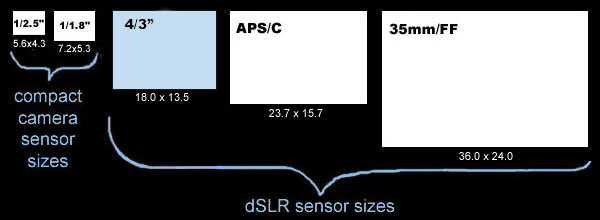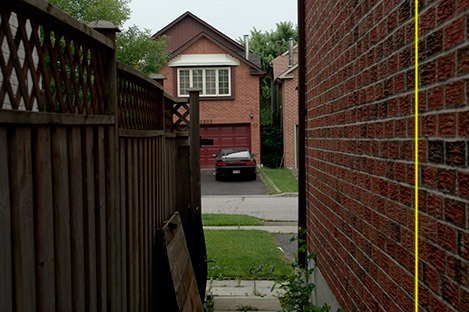Mini-review of the Olympus E-P1
(and – by extension – of the near-identical E-P2)
Page 2. Version 5.0, ©2009, 2010 by Dale Cotton, all rights reserved.
Image Quality
General

Fig. 4: Common digital sensor sizes to scale (dimensions in millimetres)
The critical thing about the E-P1 is that it uses a dSLR-sized sensor that is several times larger than the sensors found in compact cameras. This means it can collect several times as much light per exposure as a compact camera, which is particularly important in low light situations.
Next, the E-P1 is a 12 megapixel camera, which is a good general compromise between resolution and low light handling. While the E-P1's sensor is only half the size of a 35mm film frame, its image quality is quite comparable to typical recent 12 mp dSLRs in the resolution, noise, DR, and nuance.

Fig. 5: Olympus promo: E-P1 sample photo
Evaluating image quality, however, tends to be a divisive issue. In part this is because there are many elements involved that are purely subjective, such as colour accuracy and contrast; but it's also because some people shoot JPEGs – which depend entirely on the camera's JPEG engine – and some people shoot raw. Raw output is not usable until converted in software on a computer, and each of the many different conversion programs can produce very different results from the same raw image file.
Raw noise

Fig. 5: E-P1 3200 ISO noise (raw, zero NR)

Fig. 6: E-P1 3200 ISO noise (raw, strong NR)
While the E-P1's 4/3 sensor is several times larger than any sensor used in a point&shoot compact camera, it is also somewhat smaller than the (APS-C) sensors used in most other dSLRs (see Fig. 4, above). 4/3 sensors in general have a reputation for higher noise levels purely on the theoretical grounds of their necessarily smaller per-pixel light capturing area for a given megapixel count. However, noise has as much to do with the percentage of the pixel area used for light capture, circuitry insulation, and other technical considerations as it does with sheer pixel size.
Thanks to the excellent raw image files posted at Imaging-Resource.com, we know that the E-P1's sensor and image processing circuitry are essentially identical to those used in the Olympus E-30 dSLR. This means that the E-P1's underlying image noise characteristics are also essentially identical to the E-30's.
You can see that the E-P1 holds up very nicely against both Canon and Nikon APS-C dSLRs in this hardware-level comparison from DxO (click on the SNR tab).
Hint: (courtesy W. Gordon Goodsman, electronics engineer) To verify raw noise levels for yourself, simply download the Imaging-Resource.com raw files at various ISOs from the E-P1 and other cameras, download the excellent freeware FastStone imaging software, then use it to convert the raw files with zero noise reduction to create a level playing field. In FastStone make sure you have the High-quality color interpolation option on the RAW settings tab checked.)
JPEG noise

Fig. 7: E-P1 3200 ISO noise (In-camera JPEG)
The E-P1 uses the TruePic V signal processor, which generates the camera's JPEG image output. The concensus among JPEG shooters is that TruePic V does a significantly better job of juggling noise reduction, detail retention, and colour retention, than any of its predecessors.
Hint: Judge for yourself using Imaging-Resource.com's excellent Comparometer.
Resolution

Fig. 8: The 3:2 aspect ratio of a typical dSLR compared to E-P1's 4:3
The E-P1's official image size is 4032x3024 or 12.3 mp. But due to its 4:3 aspect ratio, when considering resolution (and DOF), it's helpful to think of this as being a crop in width of a 14 APS-C dSLR frame, as shown in Fig. 21.
The E-P1 contains the same sensor but has a weaker anti-aliasing (low pass) filter than the E-30 (and most dSLRs), so it should weigh in with better resolution numbers than the E-30's and at least equal to those of the Panasonic G1, which is very good indeed for 12 mp. If you're familiar with the 14.6 mp Pentax K20D or the 15.1 mp Canon 50D or 500D, you can get a good idea of the E-P1's resolution by thinking of a 4:3 crop of an image from any those cameras but needing less USM to restore acutance.

Fig. 9: 100% detail from 12mp E-P1 (raw + USM)

Fig. 10: 100% detail from 15mp dSLR (raw + USM)
Raw res: If you find it easier to judge resolution from in-the-field samples than charts, the raw samples on this page by fourthirdsuser.com look pretty good. You can use FastStone to convert these, as explained above, but bear in mind that FastStone uses the DCRaw engine for conversion and so applies no sharpening whatsoever, unlike most commercial converters.
Dynamic range
Tech talk: Dynamic range (DR), also called exposure latitude, is the range from darkest to brightest portions of the scene a camera can capture.
While the E-P1 has a respectable DR, you can see in this DxO comparison (click on the Dynamic Range tab) that the somewhat larger sensors in both Canon and Nikon APS-C dSLRs give them an edge in DR at base ISO. Similarly, dprevew.com gives the E-P1 an optimistic 9 stops for JPEG capture and a whopping 10.7 for raw. (DXO's 10.4 number derives from their methodology of accepting noise = signal as the cut-off point). As you can see from Fig. 11, my own experience is something around 9 stops for raw before noise begins to wipe out even moderately fine shadow detail. Of course, DR falls steadily as ISO increases with the E-P1 behaving no differently from most cameras in this regard.
Colour

Fig. 12: E-P1 test shot detail © Brian Mosley
The E-P1's colour capture is fully as nuanced as any modern dSLR. Colour accuracy is more a matter of white balance accuracy plus JPEG settings or the internal camera profile used by the raw converter than an intrinsic property of the camera. That said, Olympus has something of a reputation for vibrant but tasteful out-of-camera JPEG colour; and JPEG cognosenti concur that the E-P1 does not disappoint.
